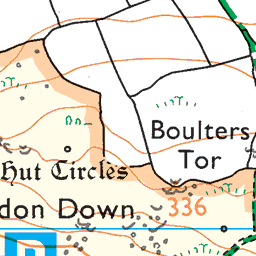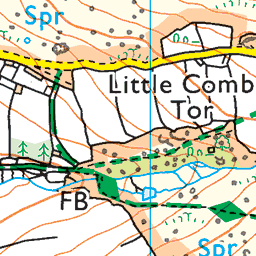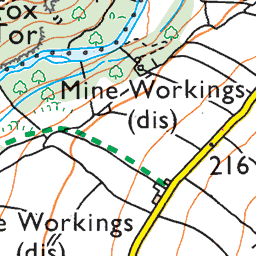TORS OF DARTMOOR
a database of both lesser- & well-known rocks and outcrops
Smeardon Down TorsSmearn Down Tors, Smear Ridge, Smearn Ridge
 William Crossing makes three references to Smearn Down and Ridge in his early works on the landscape of the moor. First in 'One Hundred Years on Dartmoor' from 1902 (5th edition) he describes the Down above Peter Tavy as "East of the village. Its crest is sometimes called Smearn Ridge and on it are several small tors Boulter's Tor at its eastern end being the principal." In the same publication Smearn Ridge is listed under the section 'The Following Rock Piles have for the most part the character of tors though that name is not given to them' and is then described as "forming the crest on Smearn Down".  Later in Gems in a Granite Setting dated 1905 the author remarking on a walk in Peter Tavy Combe he concludes with the following sentence "Descending from the crags on Smearn Down we reach the Moor gate whence a walk of a few minutes will bring us to Peter Tavy village." As you would expect from these descriptions there are several small outcrops spread across the Down none of which seem to have acquired a name for themselves. The area is now marked as Smeardon Down on OS maps and although somewhat lowly in stature the metamorphic tors here provide long views to the north west which are especially fine and take in the distant Great Links Tor and the impressive pile of Hare Tor above Tavy Cleave, with to the left of this the distinctive church-topped hill of Brent Tor.  The first two outcrops are located way down on the western slopes just above enclosure walls and overlook the church towers of both Peter and Mary Tavy villages. From here proceeding east there is progression of non-granite rock piles, seven in total according to Ringwood (2013) terminating in the only ones with names at the Boulters Tors above Twyste Lane. Since Crossing's accounts at the turn of the 20th Century the tors of Smeardon Down have received scant attention in the literature despite them being an excellent starting point for exploring Langstone Moor to the east. That said a visit in winter or early spring is recommended as the hillside above the quarry car park is choked with bracken at any other time of year. 
Please Support UsWe are proud to see the names of lesser-known tors are now being used more commonly on other websites and whilst this is to be encouraged we do request that, should you wish to use the information on this page, you provide a backlink to the website as reference, by copying the relevant address: https://www.torsofdartmoor.co.uk/tor-page.php?tor=smeardon-down-tors Please also consider a small donation to the upkeep of the site; any contribution goes toward the fees to keep the database online and any costs incurred when undertaking research such as subscriptions to online archives. | ||||||||||||||||||||||||||||



















